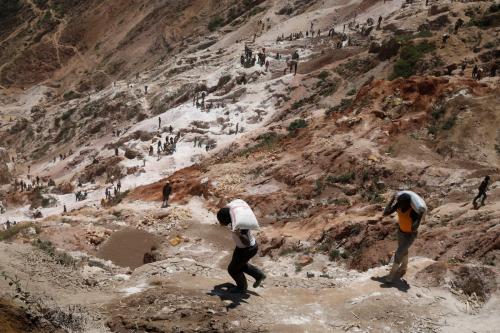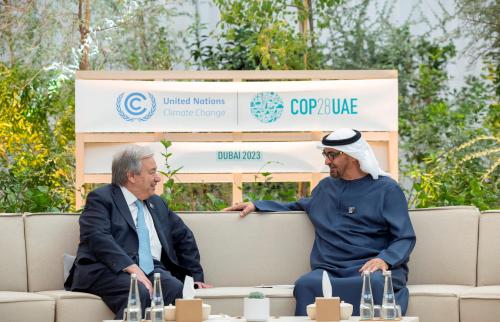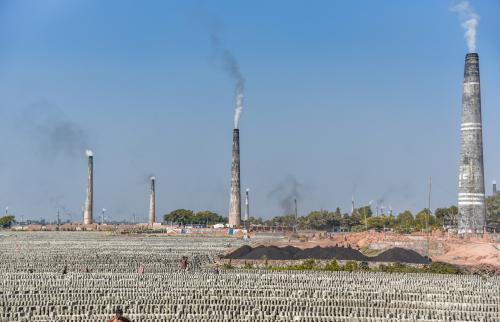I recently participated in the Joint Meeting of the Pacific Platform for Disaster Risk Management and the Pacific Climate Change Roundtable July 8-11th in Nadi, Fiji which marked the first ever attempt to bring together different regional networks working on climate change and disasters. It was a rich and eye-opening experience to be present in this gathering of several hundred people representing governments, regional bodies galore, international organizations, academics, NGOs and civil society groups. The Pacific often seems very far from Washington, but exciting things are happening in this region that deserve more attention.
It is now generally accepted that one of the consequences of climate change will be an increase in the severity, intensity and unpredictability of weather-related disasters. And yet in most regions, there are separate networks of international and regional organizations working on climate change adaptation and on disaster risk management. On the surface it makes sense to bring these networks together: surely everyone can agree that one of the ways to adapt to the effects of climate change is to reduce the risk of disasters. How can risks from disasters be considered separately from risks posed by climate change? But it’s not so simple. In this region (and everywhere), those working on disaster risk reduction are concerned not only about weather-related disasters but about geo-hazards – earthquakes, tsunamis, and volcanoes, for example. Different government ministries are involved in climate change negotiations than those who are managing national responses to cyclones and droughts. Different donors and funding mechanisms support climate change adaptation, on the one hand, and disaster management on the other. Bringing together different networks, and perhaps eventually merging networks, is easier said than done.
The meeting was an impressive gathering of many international and regional bodies. Jimmie Rodgers, Director General of the Secretariat of the Pacific Community, remarked that the convening of this meeting itself was a milestone. He noted that in 2005 two independent frameworks were adopted in the region – one on climate change adaptation and another on disaster risk management – and that it has taken eight years to bring these two together. Margareta Wahlström, Special Representative of the Secretary General of the United Nations for Disaster Risk Reduction, explained the relationship between this Pacific ‘roadmap’ to bring together these two networks by 2015 in the context of broader international efforts. 2015 will be a big year for new international frameworks, she noted, with three initiatives underway: the post- Hyogo disaster risk reduction framework, the post-Kyoto framework on climate change and new sustainable development goals. David Sheppard, Director General of the Secretariat of the Pacific Regional Environment Programme, began his comments by noting that while Pacific countries are responsible for three-tenths of one percent of the world’s greenhouse emissions, the Pacific will be the first to ‘go under’ and expressed his hopes that this historic meeting would act as an example for the world.
A theme running throughout the meeting was a call for better understanding of the landscape – who is doing what in the area of disaster risk management and climate change? How do these organizations interact with each other? Our initiative on “In the Neighborhood: The Growing Role of Regional Organizations in Disaster Risk Management” sought to provide some insights into this mapping exercise. We organized a side event, with support from the Australian Civil-Military Centre, to present the results of our study, “Roles of Pacific Regional Organizations in Disaster Risk Management” by John Hay, University of South Pacific – Cook Islands. I began by presenting a short overview of our earlier study on regional organizations, explaining that this was background for two studies we had commissioned on regional bodies – in the Caribbean and the Pacific. Among other things, the study on the Caribbean, by Mark Kirton of the University of the West Indies, had noted the overlapping membership of regional organizations in the Caribbean and called for institutional consolidation of these efforts. John Hay then presented his study on Pacific regional organizations which underscored the different capacities of these bodies in different aspects of disaster risk management. While Pacific organizations got high marks for their work in disaster risk reduction, their capacity to respond to disasters was much lower. Comments and reactions to the study were offered by representatives from the South Pacific Commission, the Pacific Humanitarian Team, the International Federation of Red Cross and Red Crescent Societies, the Caribbean Disaster Emergency Management Agency, and the University of the West Indies.
Discussion at this session, and indeed throughout the meeting, was animated. Would climate change funding become available to support disaster risk reduction activities? Would donor behavior be able to change to support this merger? What role do regional organizations play vis-à-vis international aid agencies? Representatives from the Caribbean pointed out similarities – and differences between their region and the Pacific. Two representatives from African sub-regional organizations pointed out that in their organizations all of the funding for disaster risk reduction came from foreign sources, raising questions about whether this was a priority for African member states.
What is happening in the Pacific to bring together these networks is hard work. It’s probably more difficult to deal with power dynamics and institutional interests than with the substantive tasks of developing joint programs. But just as the effects of climate change are being felt first in the Pacific, perhaps the Pacific is also leading the way in dealing with the administrative and political obstacles that prevent a more holistic approach to these issues. It’s too early to tell whether these attempts will be successful, but it was a privilege to watch a small part of the process.



Commentary
Bringing Together Disaster and Climate Change Networks: Historic Meeting in the Pacific
July 23, 2013